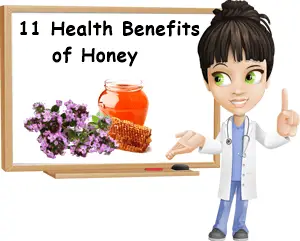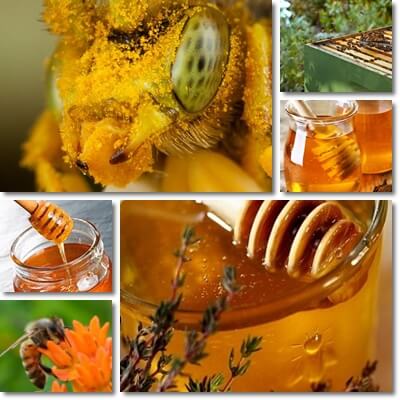Produced from flower nectar and pollen or honeydew and processed by honey bees using enzymes unique to them, honey is a healthy food whose recipe remains unaltered for millennia. What makes honey healthy is its varied therapeutic action that includes a wide range of health benefits, from healing wounds and calming cough to soothing a sore throat and healing gastritis upset naturally. Furthermore, eating raw honey is known to have a stimulating effect on the immune system, strengthen the body, combat fatigue and low energy levels and hurry recovery after disease.
Honey boasts so many uses and therapeutic effects that it has sparked great interest and become the object of scientific research. More and more studies are beginning to confirm the wonderful properties and health benefits honey has been attributed and seek to maximize its natural healing potential. One such endeavor is the development of natural wound dressings whose main active ingredient is honey. Research suggests that not only can they ensure a faster wound healing time, but they may prove a far better, less costly alternative for wound healing. Many other benefits can be obtained solely from the consumption of raw, unprocessed and unadulterated honey.

What is honey? Honey is a food obtained from either flower nectar and pollen or honeydew and processed by honey bees with special digestive enzymes. Honey made from flower nectar and pollen is often reffered to as nectar, flower or floral honey. If it’s made from honeydew, it is called honeydew honey or forest honey. Honeydew is a sugary substance very similar in composition to flower nectar. It’s secreted by certain insect species (like aphids) after they eat plant sap. Honey bees collect the honeydew and process it using digestive enzymes to make honey out of it.
Types of honey
Nectar honey can be divided into two major categories: monofloral and polyfloral. Monofloral honey, also called unifloral, is honey made predominantly from the nectar and pollen of one flowering species, but often contains smaller amounts of other types of flower nectar as well. In order for it to be classified as monofloral, there has to be one predominant nectar type. Depending on the country, region or plant species, a monofloral honey may contain as little as 10% or as much as 90% of one flower species. Evaluating the purity of a honey is done by measuring its pollen content which reveals the floral sources and determines which one is predominant and by how much.
Polyfloral types, also called multifloral or wildflower honey or millefiori honey, contain several flower nectars without one necessarily being predominant. Polyfloral honeys are thought to be superior to monofloral varieties because they contain pollen and unique elements with varied therapeutic effects from multiple plant species, which is believed to result in a stronger medicinal effect. At the same time, polyfloral honeys have a higher chance of causing potentially serious allergic reactions because of the great variety of pollen they may contain. Someone with multiple pollen allergies is statistically more likely to be allergic to polyfloral honey than to a monofloral variety whose pollen composition is known.

What is honey good for?
Because honeys have roughly the same composition, one could be led to believe they all have the same therapeutic action. But despite the fact that different varieties benefit more or less the same systems, each honey variety is unique and possesses distinctive features with a specific therapeutic effect. With this in mind, here 11 wonderful health benefits of honey in general:
1) Strengthens the immune system. Pollen particles in honey stimulate the immune system to respond better to infection and disease. They support the immune system organs to store nutrients and produce white blood cells, strengthen the body and exhibit antibiotic activity against various antibiotic-resistant bacteria. Moreover, the antibacterial and antifungal activity of honey further contributes to its beneficial effects on the immune system. The raw honey, unprocessed and unfiltered has the strongest activity.
However, honey is usually not recommended for children under 1 year or people with weak immune systems because there is a risk of fungi or bacteria presence which requires a well-developed immune system to fight it off.
2) Excellent antibacterial and antiseptic. Honeys contains strong antibacterial elements like methylglyoxal in manuka honey and hydrogen peroxide in other honeys, pollen particles, antioxidants (flavonoids, phenolic acids) with antimicrobial properties, all of which act as inhibit bacteria growth and actively destroy bacteria. Other characteristics of honey relevant to its antibacterial activity are its acidic pH, low moisture content and high content of natural sugars, elements which inhibit the growth of microorganisms.
Wound healing is a perfect example of the cumulative action of the antibacterial elements in honey. For instance, high content of natural sugars draws moisture away and thus inhibits the growth of bacteria. Hydrogen peroxide and methylglyoxal have antibiotic effects, while the low moisture content is detrimental to bacteria.
3) Good for the common cold and other respiratory infections. Honey is a known natural remedy for the common cold, flu, sinusitis, bronchitis, tonsillitis and other respiratory infections. While its antibacterial action is centered on infections affecting the throat, where it actively reduces bacteria numbers, it can be useful for other respiratory infections because it strengthens the body and stimulates the immune system response. Whenever I have a cold, I eat one tablespoon of raw honey 3-4 times a day, take vitamin C and drink plenty of liquids and recover a lot faster and without medication of any sort.
4) Calms cough and soothes a sore throat. Honey has a naturally viscous consistency which allows it to set on mucous membranes like the throat lining and form a sort of protective barrier that prevents further inflammation, allows the throat lining to recover, reduces bacteria numbers and calms cough. Studies show eating natural honey for the duration of a respiratory infection not only helps with symptoms, but also hurries recovery and aids with sleep.
5) Natural remedy for acne. Because of its antibacterial properties, honey can be used as a natural face mask or daily face cleanser to reduce the populations of acne-causing bacteria on the face. Moreover, it reduces excess sebum, the main food supply for acne-causing bacteria. Its gentle exfoliating effect helps with clogged pores, further contributing to an anti-acne effect.
6) Other skin benefits. Studies suggest honey can be a great solution to eczema and calm irritation, inflammation and exert a hydrating and nourishing action for an overall healthier skin. From my experience, honey can be used daily to nourish and hydrate dry skin, give a healthy glow to dull skin, calm sensitive skin, improve uneven skin tone appearance and reduce excess sebum. I apply raw honey on an empty face, let it sit for 20 minutes, then wash it off with cold or warm water. For me, it does wonders.
7) Good for gastritis. Honey eaten on an empty stomach can help soothe an irritated stomach and relieve discomfort. Moreover, certain honeys like manuka, kanuka and others stimulate the stomach lining to regenerate, further contributing to healing gastritis naturally. Also, studies show varieties like manuka with a high antibacterial activity inhibit the growth of Helicobacter pylori bacteria causing gastritis (read more about manuka honey UMF, MGO, KFactor). However, remember that diet and medication your doctor may prescribed are vital for gastritis treatment and honey alone may not be enough.
8) Repairs acid reflux damage. It is believed that raw honey may exert the same regenerating effect on the esophagus in acid reflux sufferers, potentially helping repair damage caused by stomach juices rising up into the esophagus.
9) Prebiotic properties, benefits transit time. The natural sugars in honey have mild prebiotic benefits, feeding the good bacteria in out intestinal tract. This contributes to better digestion, improved transit time and nutrient absorption, but also constipation relief. Some people report experiencing soft stools or mild diarrhea after eating too much honey. Eating honey is said to help improve appetite too.
10) Tonic, energizing properties. Honey contains small amounts of several essential vitamins and dietary minerals such as vitamin C, B vitamins, potassium, magnesium, phosphorus, iron, calcium etc. It also provides other elements with nutritional value like pollen, beeswax, propolis, enzymes, amino acids and natural sugars. Together, all of these elements are responsible for the nourishing effect of honey and its tonic, energizing properties. Honey is recommended to combat fatigue and low energy levels, prevent hypoglycemia and improve nutritional status.
11) Other benefits. There are also other benefits associated with honey consumption. Eating honey is believed to help induce sleep and improve sleep quality (honey is added to milk and drank before going to bed). It has been suggested it can help reduce cholesterol levels and, indeed, various elements in honey have proven cholesterol-lowering effects (pollen, for example), but the limited amounts in it is consumed are believed to not be strong enough to produce a visible effect in this respect. Lastly, raw honey is used as a natural hair mask for dry, brittle hair and dandruff.
Conclusion
Honey amazes with delicious flavor notes and impressive medicinal uses that recommend it for a surprisingly great number of health issues. Eating honey alone can help soothe stomach upset, heal gastritis naturally, prevent acne, soothe a sore throat, calm cough, strengthen the body and boost immunity, improve transit time, help relieve constipation and reverse acid reflux damage, combat fatigue and low energy levels, manage hypoglycemia and more. It’s all a matter of how we use it and how we respond to it because not everyone will benefit from eating honey in the same way. Just as important, choosing real honey, raw, unprocessed and unheated can make all the difference in terms of the health benefits we look to obtain from it.
